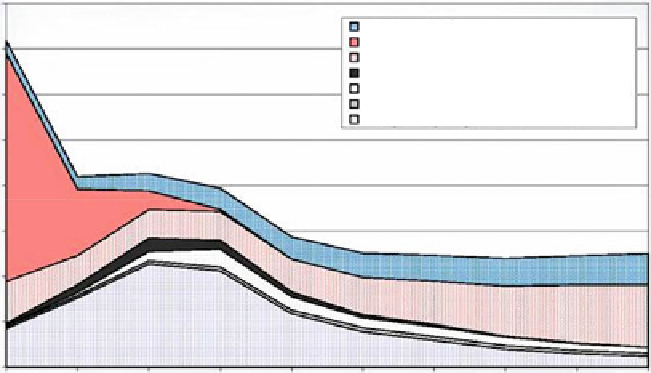Environmental Engineering Reference
In-Depth Information
40
Brake and Tire Wear
Gasoline Vehicle Lead Emissions
Gasoline Vehicle Exhaust PM
Light-Duty Diesel Exhaust PM
Lt-Hvy and Med-Hvy-Duty Diesel Exhaust PM
Diesel School and Urban Bus Exhaust PM
Heavy Heavy-Duty Diesel Exhaust PM
35
30
25
20
15
10
5
0
1975
1980
1985
1990
1995
2000
2005
2010
2015
2020
Fig. 3.22 Variation of PM
2.5
engine-released emissions along the time and in the near future, by
fuel type [
84
]
Regardless of the fuel, these engines release nitrogen oxides, carbon monoxide
(CO), particulate matter (PM), volatile organic compounds (VOC) and smaller
amounts of other pollutants like sulphur dioxide (SO
2
) and ammonia (NH
3
).
Most non-electric trains and big trucks use diesel engines, unlike cars, which
have petrol engines. Diesel engines release the same pollutants as petrol engines,
but they produce much higher quantities of PM
2.5
and smaller amounts of VOC and
CO (see for example the data presented in Fig.
3.22
). Particulate matter released by
diesel engines are considered very harmful, as the particles are extremely small and
can be inhaled very easily [
82
-
84
].
Long distance, high capacity ships, as well as large-scale fish farming activities,
naval military actions or large cruise liners are major producers of PM emissions.
Accordingly, international agreements limit marine emissions to road traffic emis-
sion levels [
84
].
Nuclear-powered ships, used almost exclusively for military purposes, are
vessels that do not release nanoparticles in the atmosphere.
A past and future perspective of PM
2.5
emissions released by both diesel and
stark-ignition engines are presented in Fig.
3.23
[
84
]. The statistical data show that
in the middle of the tenth decade of the past century, lead emissions disappeared
completely, because the method of controlling autoignition with tetraethyl lead-
based antiknock agents was abandoned.
The obvious decrease in nanoparticle emissions is the consequence of engine
manufacturers
efforts to improve technical performances and the attempts to
'

